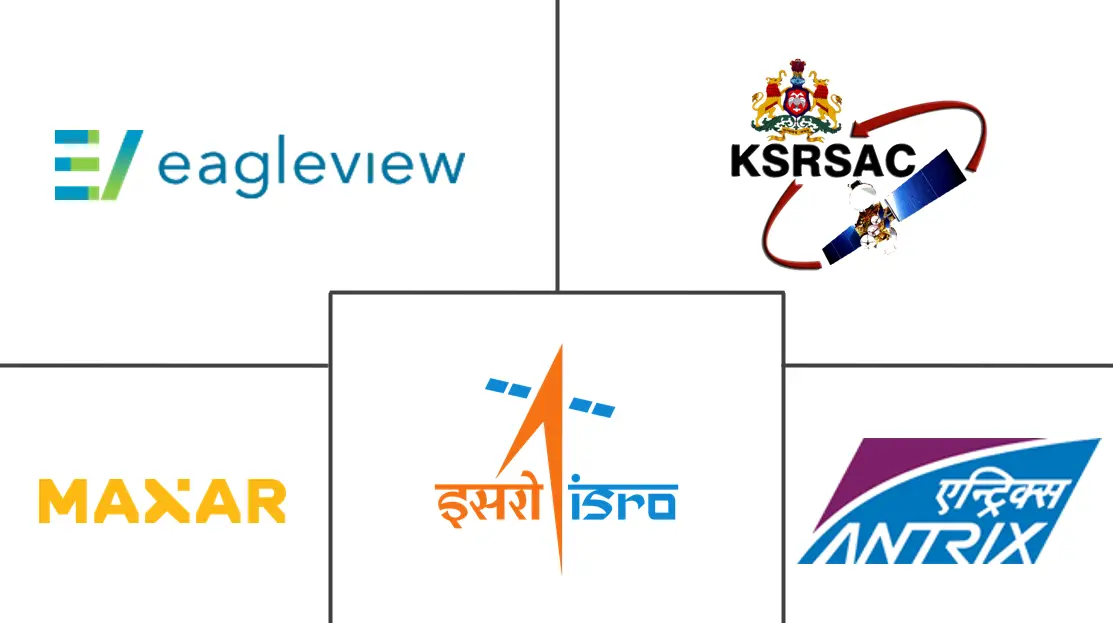India Satellite-based Earth Observation Market Size and Share
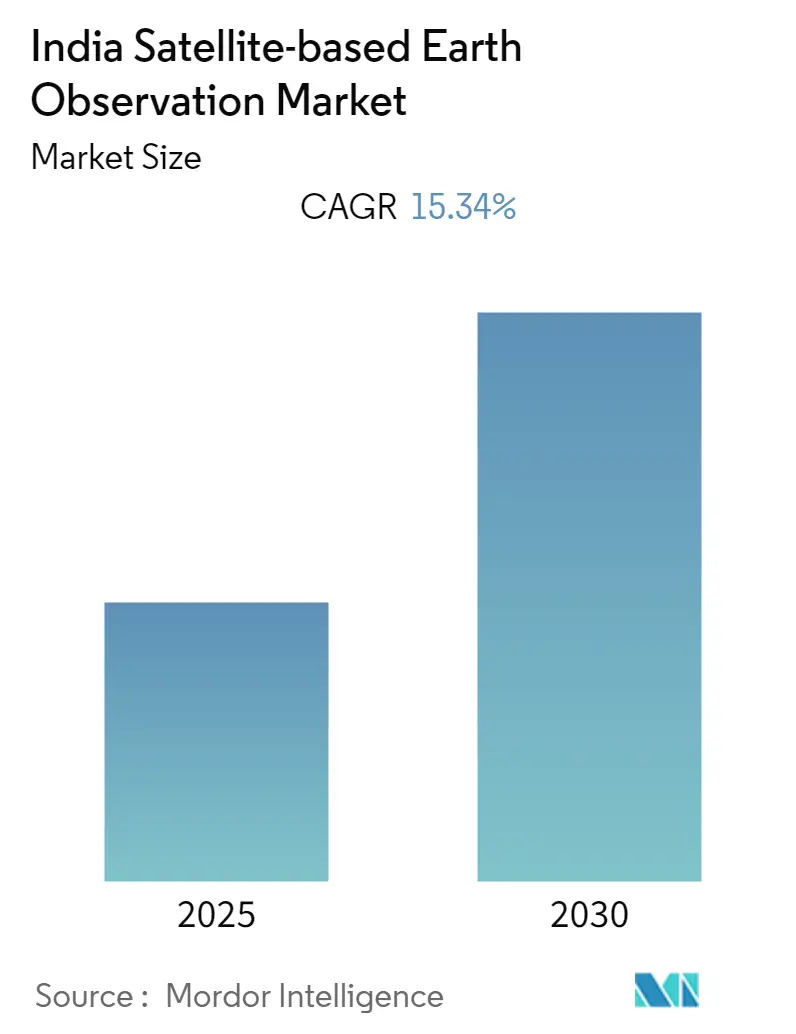
India Satellite-based Earth Observation Market Analysis by Mordor Intelligence
The India Satellite-based Earth Observation Market is expected to register a CAGR of 15.34% during the forecast period.
There is a growing demand for accurate and timely geospatial information across various sectors such as agriculture, urban planning, infrastructure development, environmental monitoring, disaster management, and defense. Satellite-based earth observation provides a valuable source of geospatial data, driving the market as the need for such information expands.
- India has made significant strides in satellite-based earth observation, primarily driven by the Indian Space Research Organisation (ISRO), the country's prominent space agency. ISRO has successfully launched several remote sensing satellites, including the Resourcesat, Cartosat, and Oceansat series, equipped with advanced imaging and sensing capabilities.
- The market is driven by various factors, including the increasing demand for accurate geospatial information, the government's initiatives and investments, technological advancements in satellite technology and data processing techniques, the need for improved agricultural practices and food security, urban development and infrastructure planning, disaster management and climate change monitoring, defense and security applications, and the emergence of commercial opportunities.
- The government of India has been actively supporting satellite-based earth observation through programs like the National Remote Sensing Centre (NRSC) and the National Geospatial Program (NGP). These initiatives aim to enhance the country's earth observation capabilities, promote research and development, and facilitate the dissemination of satellite data and geospatial information to various user sectors.
- Further, advancements in satellite technology, remote sensing instruments, and data processing techniques have significantly improved the capabilities of satellite-based earth observation. Higher-resolution imagery, improved spectral capabilities, and enhanced data processing algorithms enable more detailed and accurate Earth surface analysis. Technological advancements continue to drive market growth by providing better data quality, higher efficiency, and improved analysis capabilities.
- Despite significant advancements, satellite-based earth observation still has certain limitations. These include limitations in cloud cover, temporal resolution, revisit frequency, and accuracy of specific parameters. Overcoming technical limitations and continuously improving data quality and processing capabilities are necessary for expanding the market's potential.
India Satellite-based Earth Observation Market Trends and Insights
Government Initiatives and Investments to Drive the Market Growth
- The Indian government has taken significant initiatives and made investments to drive the growth of the satellite-based earth observation market in the country. These initiatives aim to enhance earth observation capabilities, promote research and development, and facilitate the utilization of satellite data across various sectors.
- The Indian Space Research Organisation (ISRO) is India's primary government agency responsible for space research and development. ISRO has been at the forefront of satellite-based earth observation, launching a series of remote sensing satellites equipped with advanced imaging and sensing capabilities. These satellites, such as the Resourcesat, Cartosat, and Oceansat series, have played a crucial role in gathering valuable data about the Earth's surface, atmosphere, and environment.
- Moreover, the National Remote Sensing Centre (NRSC) is a part of ISRO and serves as the nodal agency for satellite data acquisition and dissemination in India. NRSC is responsible for coordinating the utilization of satellite data and promoting its applications across various user sectors. It provides access to satellite imagery, value-added products, and services to government departments, research institutions, and other stakeholders.
- In addition, the Indian government has formulated the Indian Earth Observation Satellite (IEOS) policy to provide a framework for developing and utilizing earth observation satellites. The policy focuses on enhancing the capabilities of earth observation satellites, promoting data sharing and dissemination, facilitating international cooperation, and ensuring the utilization of satellite data for national development.
- Further, the Department of Space (DoS), which continues to be the core element of the nation's space program and carries out several significant initiatives, received INR 125.44 billion (USD 1.53 billion) from the Union Budget for 2023-2024 (FY 23). The 2023-24 Union Budget reduced the Department of Space's spending by 8%, bringing it from the previous Budget forecast of INR 137 billion (USD 1.67 billion) to INR 125.44 billion (USD 1.53 billion).
- However, this is 19% more than the updated forecast from the last fiscal year. This statistic indicates that there is still a significant allocation of funds to the Department of Space, although slightly reduced compared to the initial forecast. The fact that the budget allocation is higher than the previous fiscal year suggests that there is ongoing support for space-related initiatives and programs.
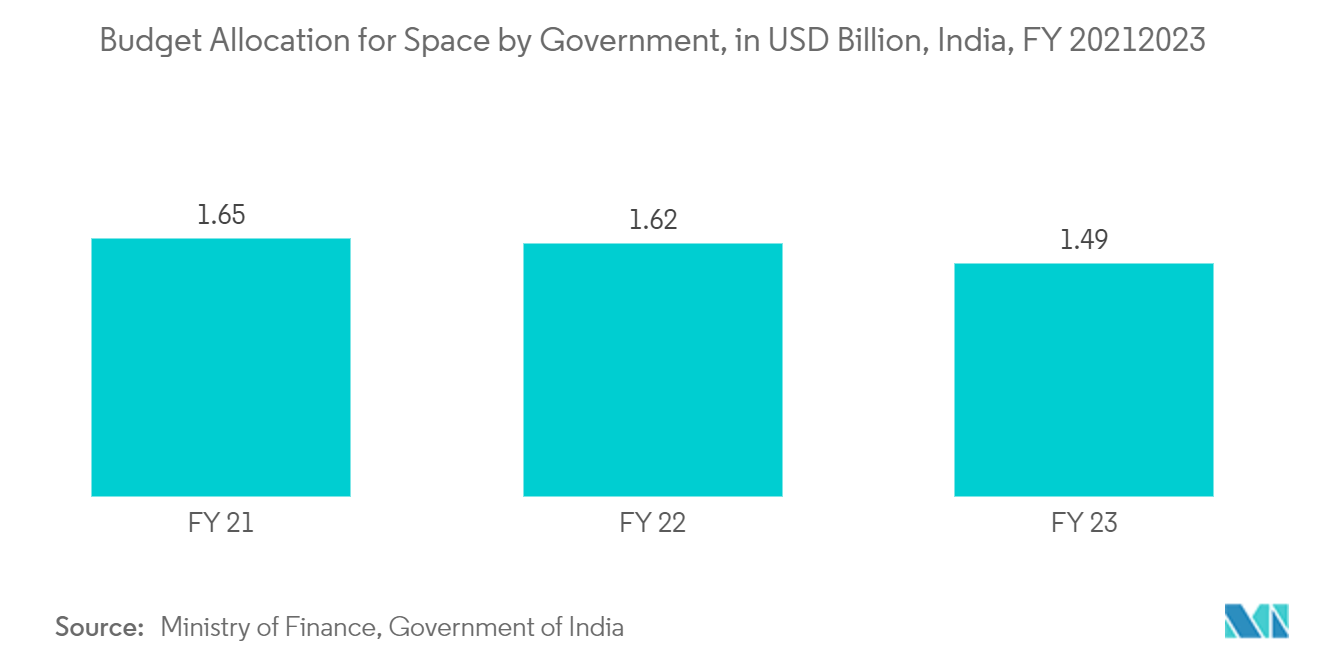
Agriculture End-use Segment to Hold a Significant Market Share
- The application of satellite-based earth observation technologies and data in the agriculture sector has gained tremendous importance due to its potential to improve farming practices, optimize resource management, and enhance overall agricultural productivity.
- Satellite-based earth observation provides valuable insights for monitoring and planning agricultural activities. It enables the assessment of crop health, vegetation indices, and land cover mapping, which helps farmers and agricultural authorities make informed decisions regarding irrigation, fertilizer application, and pest and disease management. Using satellite imagery, farmers can identify problem areas, optimize resource allocation, and take timely actions to mitigate risks and maximize yields.
- Accurate estimation and prediction of crop yields are crucial for planning agricultural production, managing supply chains, and ensuring food security. Satellite-based earth observation enables data collection on vegetation growth, biomass, and spatial variability, which can be used to estimate crop yields over large areas. This information helps farmers, traders, and policymakers make informed decisions about resource allocation, market pricing, and distribution strategies.
- In addition, the Indian government has been actively promoting satellite-based earth observation in agriculture. Initiatives such as the National Agricultural Drought Assessment and Monitoring System (NADAMS) and the Soil Health Card Scheme (SHCS) leverage satellite data to provide farmers with valuable information on soil health, crop suitability, and drought conditions. Government support, subsidies, and awareness campaigns further drive the adoption of satellite-based earth observation in agriculture.
- Further, according to the Agricultural and Processed Food Products Export Development Authority (APEDA), India's total organic area increased from roughly five million hectares in fiscal year 2012 to nearly 10.17 million hectares in fiscal year 2023. The agriculture sector can benefit from valuable insights and data to support organic farming practices by leveraging satellite-based earth observation. The information obtained through satellite imagery can contribute to sustainable agriculture planning, improve productivity in organic farming areas, and enable informed decision-making for farmers, policymakers, and other stakeholders in the agriculture industry.
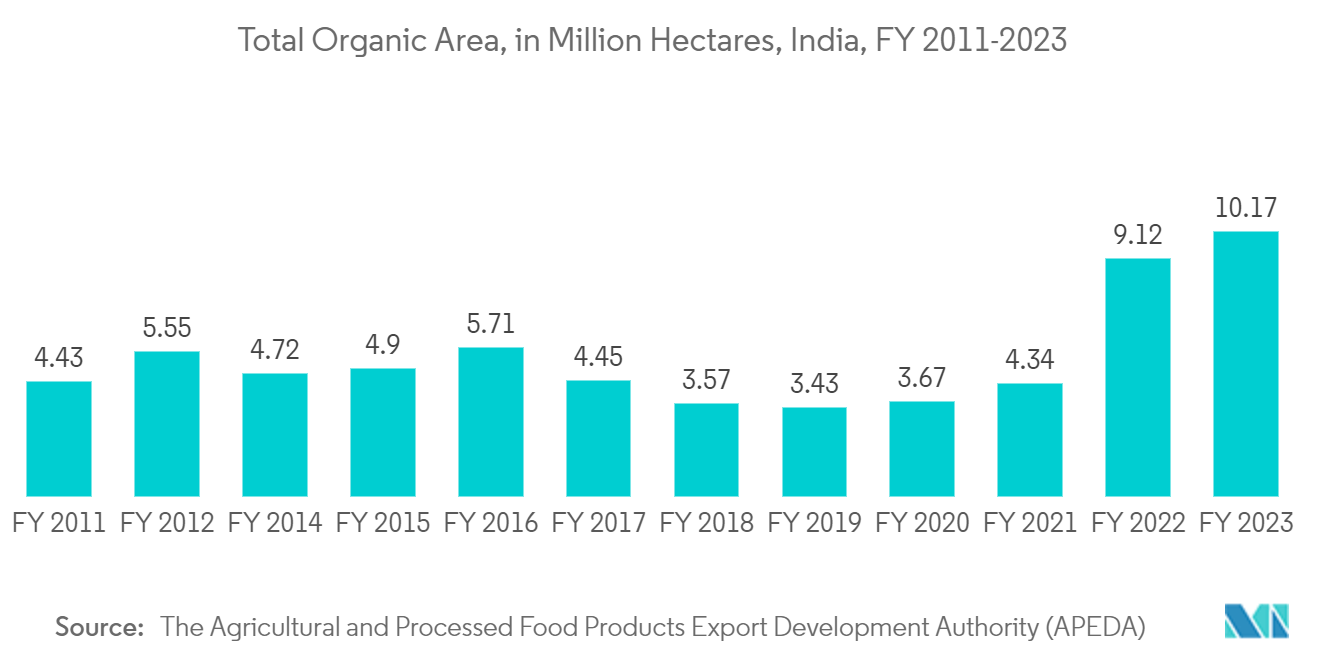
Competitive Landscape
The India satellite-based earth observation market is expected to be fragmented in nature. The market consists of various players offering satellite imagery, data analytics, and related services. These players include government agencies, research institutions, private companies, and international organizations. The India satellite-based earth observation market is characterized by a diverse range of public and private players contributing to developing and applying satellite imagery and data analytics for earth observation purposes. Indian Space Research Organisation (ISRO), Antrix Corporation Limited, Maxar Technologies Holdings Inc., EagleView Technologies, Inc., and Karnataka State Remote Sensing Applications Centre (KSRSAC) are a few prominent players operating in the market.
In June 2023, GalaxEye, a space technology business incubated at IIT-Madras, announced plans to develop the first multi-sensor earth observation satellite with a visible spectrum camera that offers synchronized imaging that can take numerous photographs simultaneously. The firm will launch its first satellite, "Drishti Mission," the following year.
In November 2022, Oceansat-3, an Earth observation satellite, and eight other client spacecraft were successfully launched by the Indian Space Research Organisation (ISRO) into two distinct orbits. Oceansat-3 is designed to observe ocean surface temperature, wind vectors, and ocean color data for oceanography, climatology, and meteorological applications. According to the ISRO, the satellite also offers value-added products, including identifying possible fishing zones using SST, wind speed, other data, and land-based applications.
India Satellite-based Earth Observation Industry Leaders
-
Indian Space Research Organisation (ISRO)
-
Antrix Corporation Limited
-
Maxar Technologies Holdings Inc.
-
EagleView Technologies, Inc.
-
Karnataka State Remote Sensing Applications Centre (KSRSAC)
- *Disclaimer: Major Players sorted in no particular order
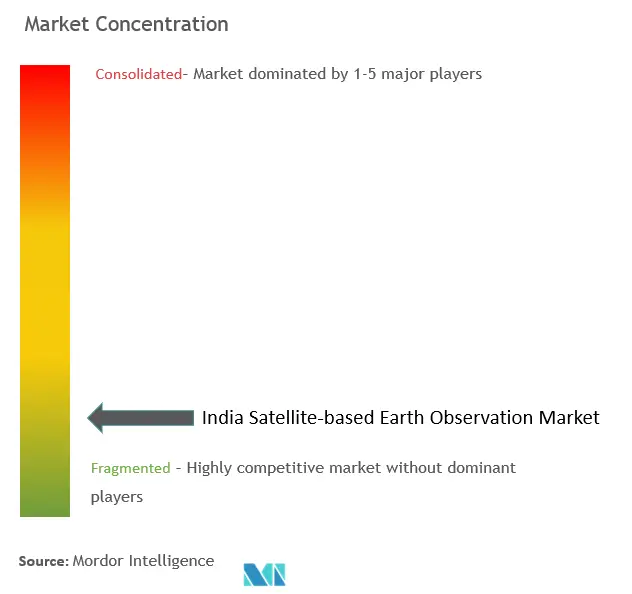
Recent Industry Developments
- Jun 2024 - The Indian Space Research Organisation (Isro) has finalized the plan for building its own space station, Bharatiya Antariksha Station (BAS), and will soon submit it to the government for approval,The final plans for Chandrayaan-4, India’s next lunar mission, which includes a crucial space docking station, and the Next Generation Launch Vehicle (NGLV), is also awaiting approval. The NGLV will replace the current heavy space launcher, Launch Vehicle Mark III (LVM3).
- March 2024 - The Indian Space Research Organisation (ISRO) will conduct the Space science and Technology Awareness Training (START) 2024 programme during April and May. In this connection, ISRO solicits Expression of Interest (EOI) to host START-2024 in educational institutes, universities, colleges within India who are offering UG and PG courses in physical sciences and technology.
India Satellite-based Earth Observation Market Report Scope
Satellite-based earth observation is done with the help of satellites orbiting around the planet to view and identify environmental changes, map making, etc. Satellite-based earth observation technology captures and stores information from satellites relating to the physical, biological, and chemical compositions of the earth for monitoring, surveillance, and decision-making in various verticals, such as defense and intelligence, infrastructure and engineering, natural resource management, energy and power, and disaster management.
The India satellite-based earth observation market is segmented by type (earth observation data, value-added services), satellite orbit (low earth orbit, medium earth orbit, geostationary orbit), and end-use (urban development and cultural heritage, agriculture, climate services, energy and raw materials, infrastructure, and other end-use).
The market sizes and forecasts are provided in terms of value (USD) for all the above segments.
| Earth Observation Data |
| Value Added Services |
| Low Earth Orbit |
| Medium Earth Orbit |
| Geostationary Orbit |
| Urban Development and Cultural Heritage |
| Agriculture |
| Climate Services |
| Energy and Raw Materials |
| Infrastructure |
| Other End-Use |
| By Type | Earth Observation Data |
| Value Added Services | |
| By Satellite Orbit | Low Earth Orbit |
| Medium Earth Orbit | |
| Geostationary Orbit | |
| By End-Use | Urban Development and Cultural Heritage |
| Agriculture | |
| Climate Services | |
| Energy and Raw Materials | |
| Infrastructure | |
| Other End-Use |
Key Questions Answered in the Report
What is the current India Satellite-based Earth Observation Market size?
The India Satellite-based Earth Observation Market is projected to register a CAGR of 15.34% during the forecast period (2025-2030)
Who are the key players in India Satellite-based Earth Observation Market?
Indian Space Research Organisation (ISRO), Antrix Corporation Limited, Maxar Technologies Holdings Inc., EagleView Technologies, Inc. and Karnataka State Remote Sensing Applications Centre (KSRSAC) are the major companies operating in the India Satellite-based Earth Observation Market.
What years does this India Satellite-based Earth Observation Market cover?
The report covers the India Satellite-based Earth Observation Market historical market size for years: 2019, 2020, 2021, 2022, 2023 and 2024. The report also forecasts the India Satellite-based Earth Observation Market size for years: 2025, 2026, 2027, 2028, 2029 and 2030.
Page last updated on:
India Satellite-based Earth Observation Market Report
Statistics for the 2025 India Satellite-based Earth Observation market share, size and revenue growth rate, created by Mordor Intelligence™ Industry Reports. India Satellite-based Earth Observation analysis includes a market forecast outlook for 2025 to 2030 and historical overview. Get a sample of this industry analysis as a free report PDF download.
